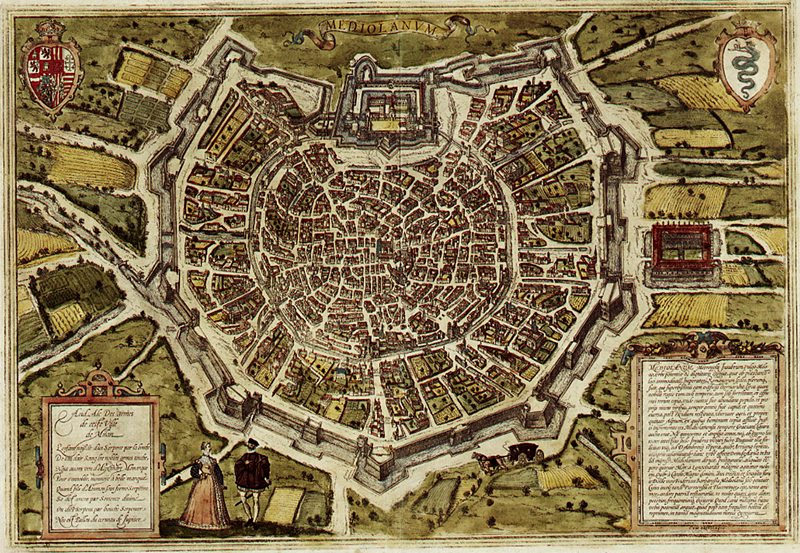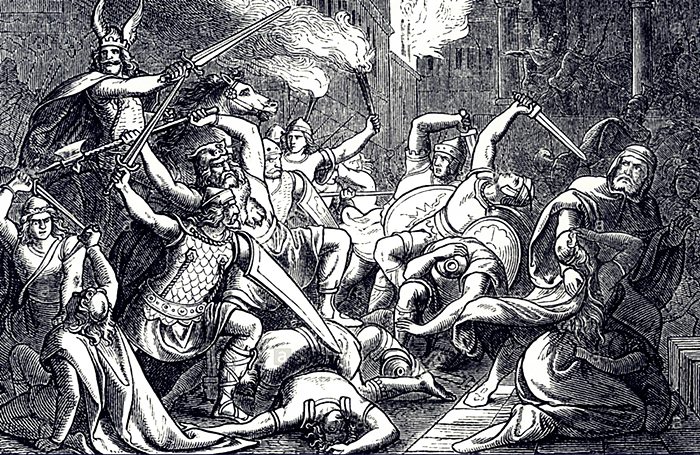
Massacre of Milan(Sack of Mediolanum) |
year: 539March 539 |
| Sack of Milan by Ostrogoths and Burgundians | ★ ★ ★ ★ ★ |
|
enemy: Ostrogoths
|
location: Milan, Italy
|
accuracy:
●●●●●
|
|
battle type: City Capture |
war: Gothic War in Italy |
modern country:
Italy |
| ▼ The Byzantines(emperor: Justinian I) | ▼ The Enemies | |
| Commander: | Mundilas | Uraias |
| Forces: | 300 | >10.000 |
| Losses: | 300,000 citizens |
| Background story: |
| In 537 or early 538, the bishop of Mediolanum (as Milan was then known) Dacius or Datius, came to Rome with a delegation of Milan citizens. Dacius asked Belisarius to send an army to liberate the city. The forces of the Ostrogoths were minimal in northern Italy because of the war in the south, Dacius said, and with a low-scale military intervention could fall into the hands of the Byzantines not only Milan but the whole of Liguria (that is, the whole of present-day northwestern Italy). Belisarius promised to help. Milan in those days was the second largest city in the West after Rome. Indeed, in the spring of 538, as soon as the siege of Rome by the Ostrogoths was over, Belisarius sent a force of 1000 Isaurians and Thracians. The commander was one of his trusted officers, Mundilas. With him was the prefect Fidelios with a small armed group of Ligurians. This force went by boat to Genoa and from there on foot to Milan carrying boats with carriages for the crossing of the river Po. The Byzantines occupied Milan without resistance and took possession of a wider area that included the cities of Bergamum, Comum, Novaria, and various other Ligurian fortresses. The only city that resisted and was not occupied was Ticinum (today's Pavia). In fact, Fidelios was killed in the battle that took place there.  το μεσαιωνικό Μιλάνο When the Ostrogothic king Vitiges heard the news, he acted swiftly and sent an army under his nephew Uraias. What Belisarius did not foresee was that the Ostrogoths received serious help from the Franks, whose kingdom (Austrasia) bordered on Liguria. The Frankish king Theudebert was an ally of the Byzantines and had been well paid for this by emperor Justinian. However, he saw the developments in Milan as a good opportunity to satisfy his expansionist ambitions. But because he did not want to appear to be violating the lucrative agreement with Justinian, he did not send an army of Franks to Liguria, but 10,000 Burgundians. Thus, at the end of 538, Milan was besieged by thousands of barbarians. It was defended by only 300 Byzantines and many of the inhabitants who were forced to take up arms to help defend the city. Meanwhile, further south, after the happy ending in Ariminon, the Byzantines continued their operations in central Italy. The two generals Belisarius and Narses acted almost independently. Despite the rivalry between the two leaders, progress had been made. Among other things, the Byzantines captured the castle of Urbinum, which surrendered when the only source of water dried up. It is characteristic that both Narses and Belisarius took part in the siege, but they had encamped in separate camps. The victory was finally credited to Belisarius who insisted on the siege, while Narses had almost left. Towards the end of 538, the main priorities of the Byzantine army were two: On the one hand the occupation of the powerful fortress at Auximus and on the other hand the relief of the siege in Milan. |
The Battle: |
 Thε sack of Milan in a 19th cent. gravure The besieged in Milan could not wait any longer. One of the deputy chiefs of Mundilas, Paul (leader of the Thracians) managed to cross the enemy lines and cross the Po swimming naked and reach the camp of the Roman reinforcements, calling for the acceleration of the intervention. They assured him that their arrival was a matter of days. At the risk of his life, Paul returned to Milan, where he carried the news that the Byzantine army was coming; and everyone was very happy. But Martin and Uliaris remained inactive. Martinos wrote to Belisarius describing his forces as hopelessly inadequate to cope with the enemy and requesting him to send John (the winner in Rimini) and Justin (magister militum per Illiricum)), who were in the neighboring province of Aemilia, to reinforce them. Belisarius complied, but John and Justin refused to move without orders by Narses. Belisarius wrote to Narses, who gave the requisite order. John proceeded to collect ships for the purpose of crossing the Po, but before his preparations were completed he fell ill. Thus delay ensued upon delay, and meanwhile the inhabitants of Milan were starving. When they were reduced to feeding on dogs and mice, Gothic envoys met Mundilas, inviting him to capitulate on the condition that he and all his soldiers should have their lives spared. He was ready to accept these terms if they would agree to spare the inhabitants. But the Goths, who were infuriated against the disloyal Ligurians, did not conceal their determination to wreak a bloody vengeance. Mundilas therefore refused. He attempted to induce the soldiers to make a desperate sally against the enemy, but, worn as they were by the sufferings of the siege, they had not the courage to attack. They compelled their leader to agree to the terms which the Goths had proposed. So Mundilas, after a winter of great hardship, was forced to surrender the city at the end of March 539. He and his men were captured and the Goths treated them well. In the city, however, unbelievable atrocities took place. All the men were slaughtered. Procopius speaks of 300,000 victims (which is perhaps inaccurate). Reparatus, the Praetorian Prefect of Italy, was found in the city. He was the brother of Pope Vigilius, but this did not save him. He was cut in pieces and thrown to the dogs. All the women were taken by the Burgundians. The city itself was razed to the ground. Martin and Uliaris returned back safe but dishonored. Uliaris was never seen again... After the fall of Milan, Uraias succeeded by the end of 539 in restoring Ostrogothic rule throughout northern Italy. |
Noteworthy: |
| In the long series of deliberate inhumanities recorded in the annals of mankind, the colossal massacre of Milan is one of the most flagrant. Historians have passed it over somewhat lightly. But the career of Attila offers no act of war so savage as this vengeance, carried out by the orders of the nephew of the Gothic king. It gives us the true measure of the instincts of the Ostrogoths, claimed by some to have been the most promising of the German invaders of the Empire. [J. B. Bury, 1923] |
Aftermath: |
| The calamity was announced to Justinian by the Pope's other brother, Cerventinus. Belisarius also sent him a detailed report. The emperor did not punish anyone, but realized that the coexistence of two leaders in the Italian campaign was problematic. So he recalled Narses. The 2000 Herules of Narses refused to continue their service under Belisarius and caused various problems later (raids, alliance with the Goths, etc.) |
|
|
